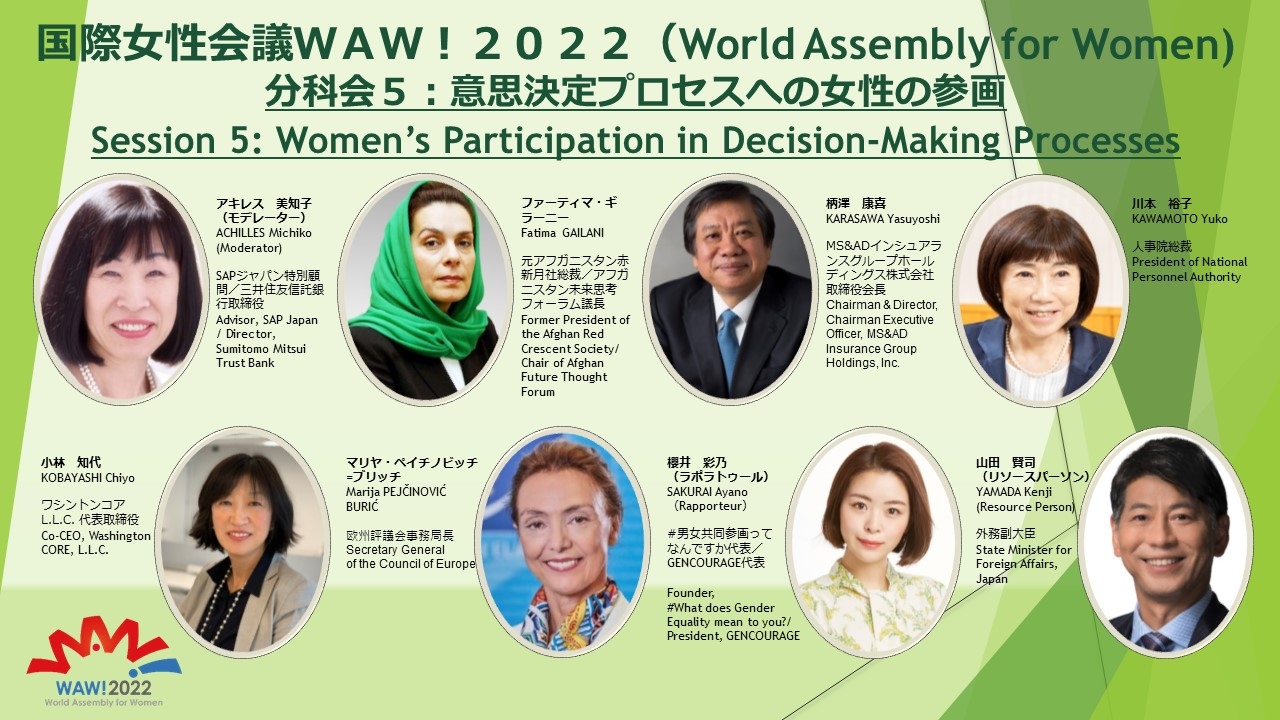Women's Empowerment and Gender Equality
World Assembly for Women: WAW! 2022
Concept Note
Women’s Participation in Decision-Making Processes
Participants (Regularly Updated)

- ACHILLES Michiko, Advisor, SAP Japan / Director, Sumitomo Mitsui Trust Bank (Moderator)
- Fatima GAILANI, Former President of the Afghan Red Crescent Society/ Chair of Afghan Future Thought Forum
- KARASAWA Yasuyoshi, Chairman & Director, Chairman Executive Officer, MS&AD Insurance Group Holdings, Inc.
- KAWAMOTO Yuko, President of National Personnel Authority
- KOBAYASHI Chiyo, Co-CEO, Washington CORE, L.L.C.
- Marija PEJČINOVIĆ BURIĆ, Secretary General of the Council of Europe
- SAKURAI Ayano, Founder, #What does Gender Equality mean to you?/ President, GENCOURAGE (Rapporteur)
- YAMADA Kenji, State Minister for Foreign Affairs, Japan (Resource Person)
Current situation and challenges to be discussed
Goal 5 (gender equality) of the United Nations Sustainable Development Goals (SDGs) aims to "ensure women’s full and effective participation and equal opportunities for leadership at all levels of decision-making(note1)”.
In Japan, women continue to be in the overwhelming minority in many decision-making situations: in the House of Councillors election in July 2022, the number of women elected reached a record high of 35 while the percentage of women in the House of Councillors is 25.8% and the percentage of women in the House of Representatives is 9.9%, ranking 166th out of 190 countries (as of September 2022 for the House of Representatives and the House of Councillors, and as of January 2021 for other countries)(note2). The percentage of women in local assemblies tends to be higher in urban areas and lower in the countryside, and there are 24 city assemblies and 251 town/village assemblies that lack female members (as of December 2021)(note3). Furthermore, the percentage of women in managerial positions, which is generally over 30% in major developed countries, is 13.2% in Japan.
There are multiple factors behind the lack of women's participation in leadership positions. Common challenges include difficulty in maintaining an appropriate work-life balance, lack of opportunities for human resource development, difficulty in continuing to work due to women's unique health issues, uncertainty about career paths, and lack of role models. In addition, gender stereotypes and unconscious bias are considered to be another common barrier in all countries. As for work-life balance the problem of long working hours in Japan has also been pointed out.
The World Bank estimates that the losses caused by gender inequality amount to approximately $160 trillion, twice the world's GDP. In Japan, labor losses due to women's health issues such as menstrual pains, premenstrual syndrome, and menopause amount to 491.1 billion yen per year, while expanding women's economic participation to the same level as men has increased GDP by 26% ($28 trillion) over 10 years and businesses that promoted gender equality and diversity in management levels grew 10-15% faster than those that did not(note4). Furthermore, in Japan, the percentage of women in their teens and twenties who migrate from rural areas to urban areas continues to be higher than that of men in the same age group(note5), which is seen as a problem contributing to the declining birthrate, aging population, and depopulation of rural areas.
At the WAW! 2022, we will specifically discuss how to accelerate women's participation in decision-making processes, which is a core strategy for realizing a new form of capitalism, in addition to realizing a society in which it is easy for everyone to live.
Discussion Topics
- What measures can be taken to promote gender equality and diversity in all decision-making processes in society and to change attitudes?
- What methods would be effective in appealing to each generation regarding the elimination of gender stereotypes and unconscious bias? What kind of education should be provided to the youth who will lead the next generation?
- What measures can be taken to promote women's participation in the political and economic spheres? What systems and measures have been adopted in other countries to increase the ratio of women in the political and economic fields, and what results have been achieved? What are the barriers to the introduction of such systems and measures and how can they be overcome? What are some good examples of women’s participation in the political, economic, administrative, judicial, and other fields? What are the challenges in countries that have already introduced the system to promote women’s participation?
- (note1) Ministry of Foreign Affairs of Japan, “SDG Indicators 5: Gender Equality”

5.5 Ensure women’s full and effective participation and equal opportunities for leadership at all levels of decision-making in political, economic and public life - (note2) 衆議院ホームページ及び IPU ホームページ (Women in politics: 2021) (Japanese)
- (note3) 総務省「地方公共団体の議会の議員及び長の所属党派別人員調べ」(Japanese)
- (note4) World Bank Group, “Unrealized Potential : The High Cost of Gender Inequality in Earnings”

JICA, “グローバルアジェンダリーフレット” (PDF) (Japanese)
(Japanese)
McKinsey&Company, “How advancing women’s equality can add $12 trillion to global growth”
McKinsey&Company,“Diversity wins: How inclusion matters”
- (note5) 内閣府男女共同参画局、“令和4年版男女共同参画白書”
 p.140 (Japanese)
p.140 (Japanese)

